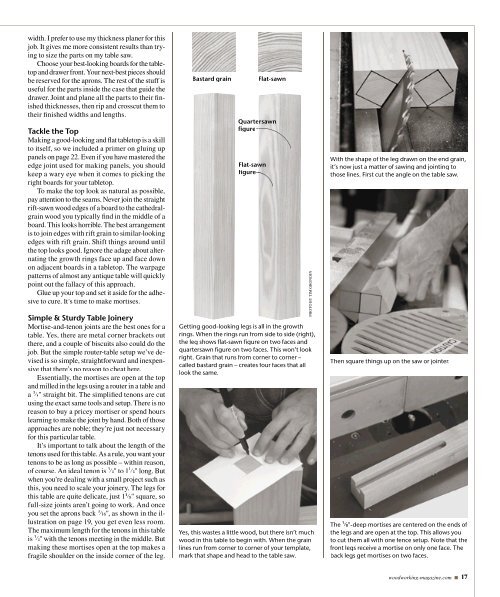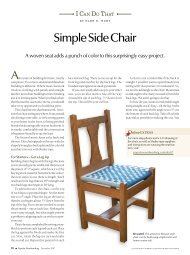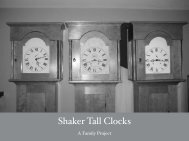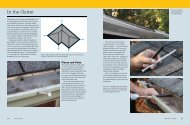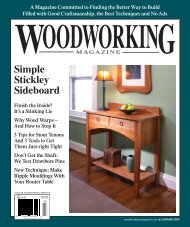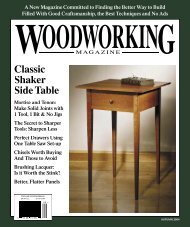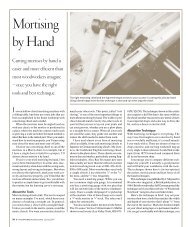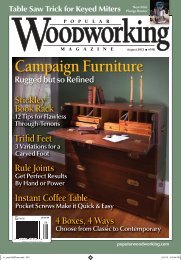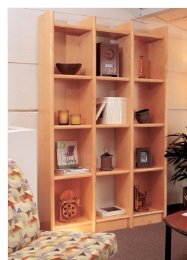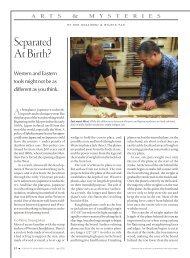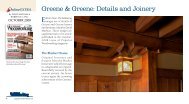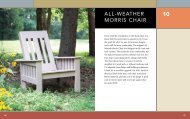Classic Shaker Side Table - Popular Woodworking Magazine
Classic Shaker Side Table - Popular Woodworking Magazine
Classic Shaker Side Table - Popular Woodworking Magazine
Create successful ePaper yourself
Turn your PDF publications into a flip-book with our unique Google optimized e-Paper software.
width. I prefer to use my thickness planer for thisjob. It gives me more consistent results than tryingto size the parts on my table saw.Choose your best-looking boards for the tabletopand drawer front. Your next-best pieces shouldbe reserved for the aprons. The rest of the stuff isuseful for the parts inside the case that guide thedrawer. Joint and plane all the parts to their finishedthicknesses, then rip and crosscut them totheir finished widths and lengths.Tackle the TopMaking a good-looking and flat tabletop is a skillto itself, so we included a primer on gluing uppanels on page 22. Even if you have mastered theedge joint used for making panels, you shouldkeep a wary eye when it comes to picking theright boards for your tabletop.To make the top look as natural as possible,pay attention to the seams. Never join the straightrift-sawn wood edges of a board to the cathedralgrainwood you typically find in the middle of aboard. This looks horrible. The best arrangementis to join edges with rift grain to similar-lookingedges with rift grain. Shift things around untilthe top looks good. Ignore the adage about alternatingthe growth rings face up and face downon adjacent boards in a tabletop. The warpagepatterns of almost any antique table will quicklypoint out the fallacy of this approach.Glue up your top and set it aside for the adhesiveto cure. It’s time to make mortises.Simple & Sturdy <strong>Table</strong> JoineryMortise-and-tenon joints are the best ones for atable. Yes, there are metal corner brackets outthere, and a couple of biscuits also could do thejob. But the simple router-table setup we’ve devisedis so simple, straightforward and inexpensivethat there’s no reason to cheat here.Essentially, the mortises are open at the topand milled in the legs using a router in a table anda 3 ⁄ 8 " straight bit. The simplified tenons are cutusing the exact same tools and setup. There is noreason to buy a pricey mortiser or spend hourslearning to make the joint by hand. Both of thoseapproaches are noble; they’re just not necessaryfor this particular table.It’s important to talk about the length of thetenons used for this table. As a rule, you want yourtenons to be as long as possible – within reason,of course. An ideal tenon is 3 ⁄ 4 " to 1 1 ⁄ 4 " long. Butwhen you’re dealing with a small project such asthis, you need to scale your joinery. The legs forthis table are quite delicate, just 1 1 ⁄ 8 " square, sofull-size joints aren’t going to work. And onceyou set the aprons back 3 ⁄ 16 ", as shown in the illustrationon page 19, you get even less room.The maximum length for the tenons in this tableis 3 ⁄ 4 " with the tenons meeting in the middle. Butmaking these mortises open at the top makes afragile shoulder on the inside corner of the leg.Bastard grainFlat-sawnQuartersawnfigureFlat-sawnfigureGetting good-looking legs is all in the growthrings. When the rings run from side to side (right),the leg shows flat-sawn figure on two faces andquartersawn figure on two faces. This won’t lookright. Grain that runs from corner to corner –called bastard grain – creates four faces that alllook the same.Yes, this wastes a little wood, but there isn’t muchwood in this table to begin with. When the grainlines run from corner to corner of your template,mark that shape and head to the table saw.PHOTO BY TIM GRONDINWith the shape of the leg drawn on the end grain,it’s now just a matter of sawing and jointing tothose lines. First cut the angle on the table saw.Then square things up on the saw or jointer.3⁄8The 3 ⁄ 8 "-deep mortises are centered on the ends ofthe legs and are open at the top. This allows youto cut them all with one fence setup. Note that thefront legs receive a mortise on only one face. Theback legs get mortises on two faces.woodworking-magazine.com ■ 17


